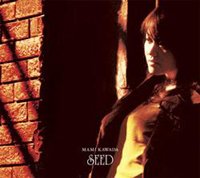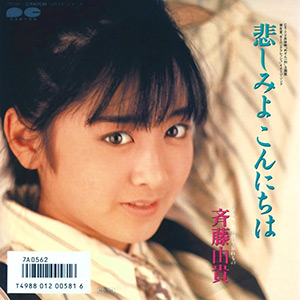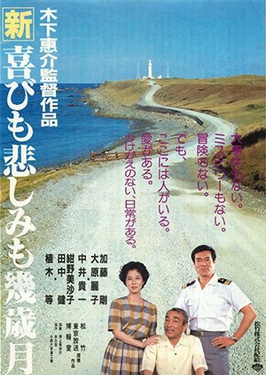Eiko Kawashima, known as Anri (杏里), is a Japanese pop singer-songwriter, originating from Yamato, Kanagawa Prefecture.

"Kanashimi Twilight" is the thirty-third single of idol group Morning Musume. It was released on April 25, 2007 and was the last single for Hitomi Yoshizawa as well as Miki Fujimoto.
Kazuhiro Moriuchi known professionally as Shinichi Mori is a Japanese male enka singer and composer, who also sings folk and pop music. He has sold more than 90 million records, making him one of the best selling Japanese musicians.

Seed is Mami Kawada's debut album which was released on March 29, 2006. This album is under Geneon and was produced by I've Sound. This album also includes her first two singles "Radiance / Chi ni Kaeru: On the Earth", and "Hishoku no Sora" and the collaboration single "Face of Fact " with KOTOKO. It peaked at the #12 spot in the Oricon charts and charted for 5 weeks.
Gorō Matsui is a Japanese lyricist born 11 December 1957 in Gifu Prefecture, Japan, though he considers Tokyo to be his hometown. Beginning with participation in the Yamaha Popular Song Contests, he made his debut writing the lyrics for the 1981 Chage and Aska album Hot Wind.

"Shining Star" Wasurenai Kara (忘れないから) is Nami Tamaki's fourth single. It was used as the ending theme for the TV Variety show Matthew's Best Hit TV. It reached number 9 on the Oricon chart.

"Vanilla" is singer-songwriter Leah Dizon's fifth single. It was released on June 25, 2008 and came in a Limited Edition CD+DVD version and a CD-only version which featured the bonus track "悲しみと笑顔の中で". The title track is an up-tempo dance tune "overflowing with R&B taste", while the B-side LOVE SWEET CANDY is a "medium-tempo reggae song."
Tatsuya Maeda is a Japanese musician and singer from Japan. Maeda is best known as the singer and guitarist of the theme songs of Ultraman Dyna and Blue SWAT.
Little by Little was a Japanese pop rock band, consisting of vocalist Hideco and Tetsuhiko. little by little's record label is Sony Music Entertainment Japan and they are attached to Stardust Promotion. They are known mainly for their contributions to anime, including "Kanashimi wo Yasashisa ni" (悲しみをやさしさに), the opening theme for the third season of Naruto, "Love & Peace", the second opening theme to Superior Defender Gundam Force, "Hummingbird", a closing theme for Yakitate!! Japan, and "Kimi Monogatari" (キミモノガタリ), the third closing theme of Naruto: Shippūden.

Ring Tour 2009 is the name of Miliyah Kato's third tour. It was released as a DVD on May 26, 2010. The DVD was recorded on November 18, 2009 at the Nippon Budokan arena. It's the #34 Music DVD of 2010 in Japan.

Funuke Show Some Love, You Losers! is a 2007 Japanese film directed by Daihachi Yoshida, based on the novel by Yukiko Motoya.
"Good Girls Go to Heaven (Bad Girls Go Everywhere)" is a song written by Jim Steinman. It was first performed by Megumi Shiina as "Kanashimi Wa Tsudzukanai" (悲しみは続かない, lit. "sadness doesn't last") and used as the opening to the 1986 Japanese TV drama Kono Ko Dare no Ko? The song was first performed in English by Pandora's Box, on their 1989 album, Original Sin, with Holly Sherwood singing lead vocals.
Sorrow Is Only for Women is a 1958 Japanese drama film written and directed by Kaneto Shindō.

"Kanashimi yo Konnichi wa" is the fifth single by Japanese singer Yuki Saito. Written by Yukinojo Mori and Kōji Tamaki, the single was released March 21, 1986, by Canyon Records together with "Ohikkoshi, Wasuremono".
Forever to Me (Owarinaki Kanashimi) (終わりなき悲しみ, Endless Sorrow) is The Brilliant Green's twelfth single, released in 2002. It peaked at #10 on the Oricon singles chart.

"Kanashiki Amefuri / Adam to Eve no Dilemma" (悲しき雨降り/アダムとイブのジレンマ) is the 22nd major single by the Japanese female idol group Cute. It was released in Japan on July 10, 2013.
Daria Kawashima, known before as Miki Kawashima, is a Japanese musical composer, singer-songwriter, lyricist under Being Inc. records.

This is a list of music of the Maison Ikkoku series. It lists individual theme and other songs, singles, as well as music, drama, and collection albums from the anime and live-action releases as well as game soundtracks.

Big Joys, Small Sorrows is a 1986 Japanese film directed by Keisuke Kinoshita, revisiting his melancholic earlier work, Times of Joy and Sorrow (1957), of a lighthouse keeper and the transient lifestyle he and his family endure. Shot at 10 different lighthouses, four temples, and various scenic locations, spanning the length of Japan from Kyushu to Hokkaido, the film serves a secondary purpose as an insightful time capsule travelogue of early 1980s Japan. It is Kinoshita's 48th and last film.











